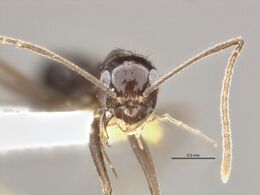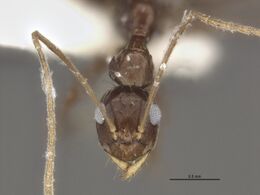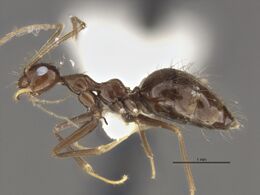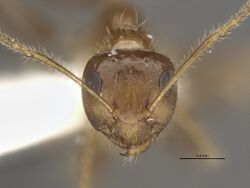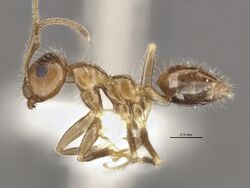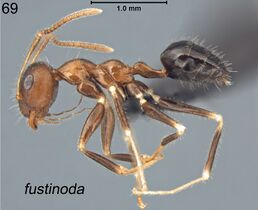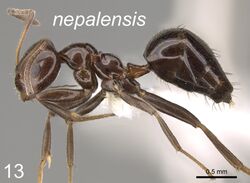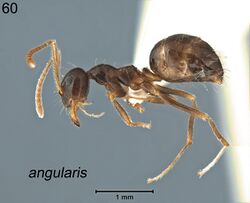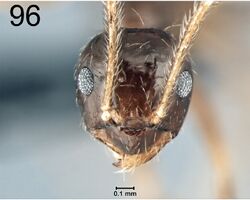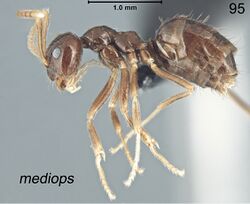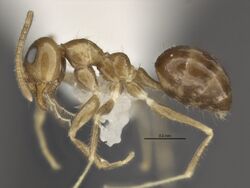Key to Prenolepis
This worker key is based on: Williams, J.L., LaPolla, J.S. 2018. Two new Prenolepis species (Hymenoptera: Formicidae) from Indomalaya and Australasia, with a redescription of P. dugasi from Vietnam. Zootaxa 4441:71-180 (DOI 10.11646/zootaxa.4441.1.10).
You may also be interested in
1
- In profile view, dorsal face of propodeum flattened and much longer than the rounded posterior face, giving propodeum an elongate appearance; scale of petiole flattened, forming a right angle at its anterodorsal point . . . . . Prenolepis lakekamu
- In profile view, dorsal face of propodeum about as long as posterior face and propodeum does not appear elongate; scale of petiole either rounded or pointed and does not form a right angle at its anterodorsal point . . . . . 2
2
return to couplet #1
- In profile view, petiole narrow and elongate with rounded dorsal apex of the scale . . . . . 3
- In profile view, petiole short and broad and forward-inclined with sharply-angled dorsal apex of the scale . . . . . 8
3
return to couplet #2
- Ocelli absent; compound eyes surpassing the lateral margins of head in full-face view; scapes with appressed setae . . . . . 4
- Three small ocelli present; compound eyes not surpassing the lateral margins of head in full-face view; scapes with erect setae . . . . . 6
4
return to couplet #2
- Small (TL < 2.70mm), robust with short legs, antennae, and mesosoma; body light to medium brown; in profile view, posterodorsal part of propodeum obtusely angled (Fig 20); petiolar scale low in profile with a weakly sinuate anteroventral outline (Fig 54) . . . . . Prenolepis jacobsoni
- Medium to large (TL > 2.70mm), gracile with elongate legs, antennae, and mesosoma; body uniformly dark brown to black; posterodorsal part of propodeum in profile view roundly produced, much higher than pronotum (Figs 21, 27); petiolar scale high in profile with a roughly subtriangular anterodorsal outline and almost straight ventral outline (Figs 55, 56) . . . . . 5
5
return to couplet #4
- Overall cuticle shiny and smooth to lightly reticulate; pubescence completely absent on the dorsal surface of pronotum, propodeum, or gaster . . . . . Prenolepis jerdoni
- Overall cuticle dull and finely reticulate; thick patches of pubescence present on the dorsal surface of pronotum, propodeum, and gaster . . . . . Prenolepis subopaca
6
return to couplet #3
- Body uniformly dark brown to black; head roughly subtriangular in shape; cuticle of head lightly reticulate; ectal surface of mandibles with light longitudinal striations; in profile view, the ventral surface of petiole almost straight (Fig 55) . . . . . Prenolepis fisheri
- Head and mesosoma light brown in overall color; ectal surface of mandibles smooth and shiny; in profile view, the ventral surface of petiole is curved upward toward the anterior articulation with the metanotum (Figs 51, 52) . . . . . 7
7
return to couplet #6
- Body light brown with little to no difference in color among head, mesosoma, and gaster; head roughly square in full-face view; cuticle of head lightly reticulate; in profile view, dorsal outline of petiolar scale roughly subtriangular in shape (Fig 51) . . . . . Prenolepis darlena
- Head and mesosoma light brown and gaster distinctly dark brown to black; head roughly subtriangular in full-face view; cuticle of head finely rugoreticulate giving dull appearance; in profile view, petiole club-shaped with dorsal outline of petiolar scale rounded (Fig 52) . . . . . Prenolepis fustinoda
8
return to couplet #2
- In full-face view, compound eyes strongly convex, surpassing the lateral margins of head . . . . . Prenolepis naoroji
- In full-face view, compound eyes weakly convex and not surpassing lateral margins of head; (Figs 38, 42, 45, 46, 48, 49) . . . . . 9
9
return to couplet #8
- Body medium to dark brown with dark brown to black gaster; cuticle of propodeum finely rugoreticulate . . . . . 10
- Color variable; cuticle of propodeum smooth and shiny . . . . . 11
10
return to couplet #9
- Cuticle of head smooth and shiny . . . . . Prenolepis cyclopia
- Cuticle of head finely rugoreticulate, giving dull appearance . . . . . Prenolepis striata
11
return to couplet #9
- Three small ocelli present; head subtriangular in shape with straight posterior margin . . . . . 12
- Ocelli absent; head shape and posterior margin variable, but not subtriangular . . . . . 13
12
return to couplet #11
- Body light to medium brown; torulae do not overlap with posterior border of clypeus; clypeal tooth with single seta extending from its point found medially on anterior border of clypeus; erect macrosetae on dorsum of head; abundant suberect setae on scapes and legs; no appressed pubescence on scapes and legs; in profile view, mesonotum is continuous with pronotum . . . . . Prenolepis dugasi
- Body medium to dark brown; torulae overlap with posterior border of clypeus; no medial clypeal tooth on anterior border of clypeus; no erect macrosetae on dorsum of head, scapes, and legs; scapes and legs are covered in appressed pubescence; in profile view, mesonotum humped anteriorly and discontinuous with pronotum . . . . . Prenolepis nepalensis
13
return to couplet #11
- Large (TL > 4.25mm); in profile view, propodeum with a rounded dorsal face (Fig 23); head and mesosoma yellow-brown, and gaster dark brown to black . . . . . Prenolepis melanogaster
- Small to medium (TL < 4.25mm); in profile view, propodeum with flat to softly rounded dorsal face, posterodorsally obtusely angled (Figs 15, 19, 22, 25, 26) . . . . . 14
14
return to couplet #13
- Body dark brown, with faint blue cuticular iridescence . . . . . Prenolepis angularis
- Body light to dark brown, without faint blue cuticular iridescence . . . . . 15
15
return to couplet #14
- Compound eyes round in shape, medium-sized (distinctly smaller than those of other Prenolepis species); interocular distance relatively long . . . . . Prenolepis mediops
- Compound eyes oval in shape, relatively large; interocular distance relatively short) . . . . . 16
16
return to couplet #15
- Ectal surface of mandibles smooth and shiny, without longitudinal striations; in profile view, mesonotum humped anteriorly and discontinious with pronotum (Fig 26) . . . . . Prenolepis shanialena
- Ectal surface of mandibles with deep longitudinal striations; in profile view, mesonotum continuous with pronotum . . . . . 17
17
return to couplet #16
- Ectal surface of mandibles with shallow longitudinal striations; mandibles with 5 teeth on masticatory margin; distributed in China (Hunan) . . . . . Prenolepis quinquedenta
- Ectal surface of mandibles with deep longitudinal striations; mandibles with 5-7 teeth on masticatory margin; distributed in Europe or North America . . . . . 18
18
return to couplet #11
- In profile view, mesosoma more robust at the mesonotal constriction (Fig 25); distributed across southeastern Europe, the Balkan Peninsula, Turkey, and east to Georgia . . . . . Prenolepis nitens
- In profile view, mesosoma slender at the mesonotal constriction (Fig 19); distributed across North America, from southern Canada to Mexico . . . . . Prenolepis imparis








